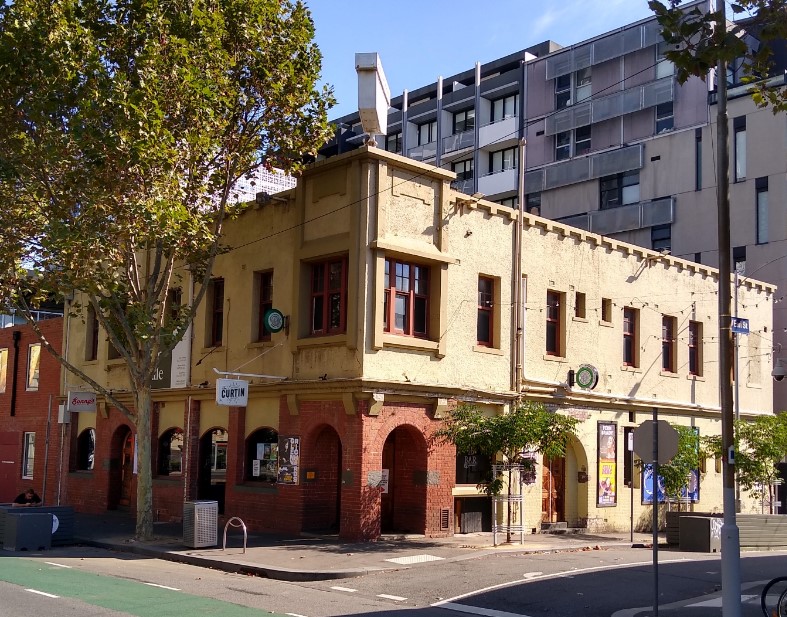
Image Credit: Wikimedia
January 2023
The threat of redevelopment of the historic John Curtin Hotel in Carlton has eased after Heritage Victoria announced on 25 July that the Curtin has been recommended for inclusion on the Victorian Heritage Register due to its ‘state level significance’.
Concern about the future of the John Curtin Hotel arose when it was announced in February that the hotel was up for sale and that its lease would not be renewed when it expires in November. Concern increased in April when it was revealed that the hotel had been sold to an overseas buyer.
The potential loss of the Curtin triggered a range of responses. Strong reactions came from the many people aware of its long connection with the union movement in general, and Prime Minister Bob Hawke in particular. As Victorian Trades Hall secretary Luke Hilakari told The Age ‘Every union secretary and most Labor prime ministers have had a beer in there. When Hawke died, it was at The Curtin that both Dan Andrews and Bill [Shorten] went to have a beer to remember him.’ In fact, the pub’s links with the labour movement resulted in it being renamed the John Curtin Hotel in 1971 in honour of Australia’s respected wartime Labor leader.
Many others saw it as another nail in the coffin of Melbourne’s live music scene, with the loss of The Curtin’s upstairs bandroom joining the long list of live music venues to close their doors (see https://beat.com.au/the-iconic-melbourne-live-music-venues-we-dearly-miss-from-the-last-30-years/ for a list of some of the iconic venues Melbourne has lost). The Curtin was also known for welcoming First Peoples communities – as well as a venue for both established and up-and-coming bands, the John Curtin Hotel hosted Aboriginal band nights in the 1980s and 1990s.
When it became known that The Curtin had been sold to overseas investors, others feared that it would be replaced by yet another characterless commercial building or block of apartments, further diluting Lygon Street’s character and appeal.
People concerned about Melbourne’s physical heritage pointed out that the Curtin was not without architectural significance. As the Royal Historical Society of Victoria (RHSV) noted ‘Built in 1915, it was designed in the arts and crafts style by Billing Peck and Kempter, a distinguished firm of architects involved with many iconic Melbourne buildings.’ No less important, it was one of the last pubs built or rebuilt before the introduction of six o’clock closing in 1916. As such, it is one of the last examples of a pub that did not have to cater for the ‘six o’clock swill’, the last-minute rush to buy drinks before closing at 6pm. The John Curtin was able to keep its more civilised arrangements of bars, reflecting a time when taking on board the desired amount of alcohol was a more leisurely affair.
The proposed sale of the Curtin has also drawn attention to a major shortfall in heritage protection laws. As the RHSV pointed out, despite the John Curtin Hotel having a Heritage Overlay, which should at least cover the building’s essential heritage elements, it is also covered by a Design and Development Overlay (DDO) that allows development of up to eight stories on the site. (Memories of the Corkman Hotel fiasco resurfaced for many – at the time of that historic hotel’s illegal demolition, it was also covered by a DDO that allowed a 12 story building to be constructed on the site. So if it hadn’t been demolished, the Corkman’s likely fate was still to become an apartment or office block.)
But perhaps the strongest response came in the form of a declaration of a Green Ban by Victorian building unions on the site. Green Bans, formerly known as Black Bans date back to 1969 when the Builders Labourers Federation banned work on demolition of houses in Carlton North. Subsequent bans saved major heritage sites across Melbourne during the 1970s, including the Queen Victoria Market, the Regent Theatre, and Flinders Street Station. The Green Ban on the John Curtin Hotel is the first in 40 years. As well, the National Trust and Victorian Trades Hall Council joined together to nominate The Curtin for inclusion on the Victorian Heritage Register.
With the announcement that the Curtin has been recommended for listing on the Victorian Historical Register, its future to continue in its present form is more secure. As long as the Heritage Council of Victoria accepts the recommendation, the owners will not be able to alter the Curtin without Heritage Victoria’s approval. So public indignation, the work of the heritage preservation community, and industrial action looks like it was able to save a significant piece of Melbourne’s history and culture.
To read full statement from 24th March 2022 click here

 239 A'Beckett Street Melbourne, Victoria, 3000
239 A'Beckett Street Melbourne, Victoria, 3000  03 9326 9288
03 9326 9288  office@historyvictoria.org.au
office@historyvictoria.org.au  Office & Library: Weekdays 9am-5pm
Office & Library: Weekdays 9am-5pm

